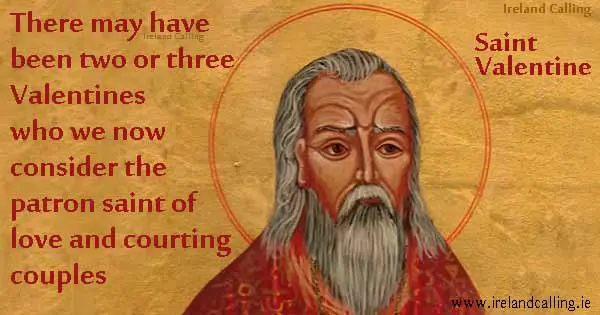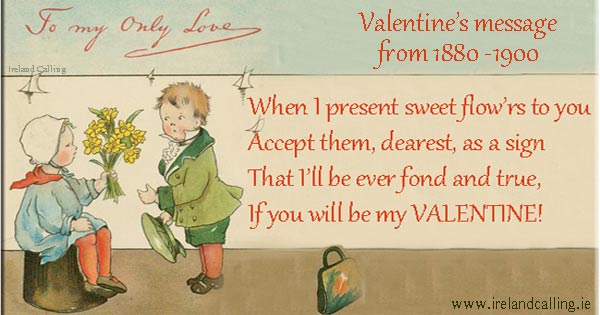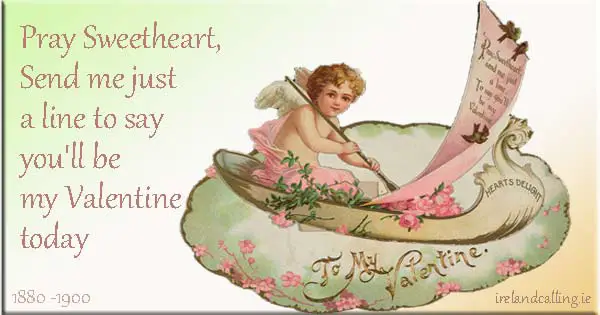St Valentine’s Day is celebrated in Ireland, as throughout many other countries, as a time for love and romance.
Unlike many traditions, however, it probably owes more to modern commercialism than it does to any ancient customs.
The desire to sell cards, flowers, chocolates etc has led big business to imbue St Valentine with romantic character he probably did not have.

The trouble is that historians can tell us very little about St Valentine, and there may even have been two or three Valentines who we now consider the patron saint of love and courting couples.
We do know that there was a Roman priest called Valentine who lived in the third century. He was executed for his Christian beliefs and was buried in the Via Flaminia to the north of Rome on February 14. He was later made a saint because of his martyrdom.
There was also a Valentine who performed illegal wedding ceremonies for soldiers. This angered the authorities because married men did not have to go to war.
The weddings may have had something to do with Valentine being associated with love, but it’s unlikely that this was the same Valentine who was later executed on February 14.

Very little was heard of Valentine for the next 1,000 years until the English poet Geoffrey Chaucer got involved.
Chaucer’s interest was possibly sparked by the idea of courtly, romantic love, which was becoming very popular in France and Western Europe in the Middle Ages.
Until that time, love and marriage were a very practical affair with couples often pairing off to increase their wealth and status. Marriages were often arranged by parents rather than the couples themselves.
Romantic love still thrived, of course, but it was more likely to be frowned upon than celebrated, especially if it meant falling in love with someone from a lower social class.
That changed in the Middle Ages, at least as far as literature and music was concerned. Poets and musicians travelled across Europe telling tales of romantic love and swearing eternal devotion to the woman of their dreams.
The concept of unrequited love was celebrated. This usually meant the poet describing his heartache because he and his lover were being kept apart, perhaps by their parents, or perhaps because one them had been forced to marry for commercial and family reasons.

With romantic love now celebrated, stories emerged of lovers exchanging cards, often in secret, or sending each other sweets and flowers.
In the 14th century, Chaucer took some of these ideas and began to associate love and romance with St Valentine. It’s not clear why.
It may be that St Valentine’s Day, February 14, marked the approach of spring when a person’s thoughts turned towards love after the long hard days of winter. Birds were thought to pair off at around this time.
In the Parliament of Foules, Chaucer wrote these lines, which are thought to be the first time St Valentine’s Day is associated with romance.
For this was on seynt Volantynys day
Whan euery bryd comyth there to chese his make.
Modern English:
For this was on St Valentine’s Day,
When every bird comes to choose his mate.
The romantic association was strengthened by the fact that the poem was written in 1382 to celebrate the engagement of King Richard II of England to Anne of Bohemia. They were only 15 years old when they married.
St Valentine’s Day became associated with romance at around this time and it began to feature more in literature.
In 1601, Shakespeare refers to it in a speech by Ophelia in the play, Hamlet:
To-morrow is Saint Valentine’s day,
All in the morning betime,
And I a maid at your window,
To be your Valentine.
Most people will have heard versions of Valentine poems beginning, Roses are red, violets are blue… and perhaps associated them with some modern day greetings card company. In fact, they date back until at least the 18th century.
These lines featured in a selection of nursery rhymes called Gammer Gurton’s Garland, published in 1784.
The rose is red, the violet’s blue,
The honey’s sweet, and so are you.
Thou art my love and I am thine;
I drew thee to my Valentine:
The lot was cast and then I drew,
And Fortune said it shou’d be you.
In 1797, the Young Man’s Valentine Writer was published in England. It contained a selection of verses for lovers to send to each other if they were unable to compose their own message.

Valentine’s Day continued to grow in popularity and by the middle of the 19th century, cards and romantic greetings were being mass produced on an industrial scale, especially in America.
By the dawn of the 20th century, it was big business with people starting to exchange gifts as well as cards. Soon romantic meals, holidays and jewellery became part of the celebrations, taking St Valentine’s Day to a scale where many people now think it has become over-commercialised.
However, with 190 million cards sent each year in the United States alone, its popularity shows little sign of declining.

Whatever your opinion on this, now, commercialised love fest, there’s no doubt that there’s a lot of humour to be found in the thoughts of the romantic… and the not so romantic.
More history articles
The Neolithics – first people to leave their mark on Ireland